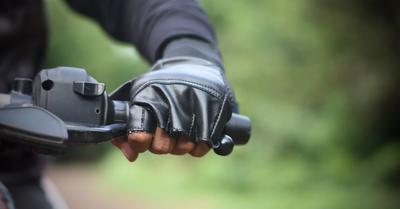What Are the Different Types of Motorcycle Helmets?
As stated above, six primary types of helmets are available on the market. Each type of helmet has its benefits and its drawbacks. Your choice of which kind of helmet will come down to personal preference and riding style.
There is one thing I can say about helmets that is universally true, and that is that wearing a helmet is always a good idea. Helmets exist to protect your head and neck in the event of an accident. If any piece of gear can be considered most important, it is your motorcycle helmet.
I’m going to start by diving into what is probably the most common type of helmet, the full-face helmet.
Full-Face Helmets
A full-face helmet is what it sounds like. It is a helmet that covers your entire face and head. If you were to pluck the image that comes to mind of a motorcyclist out of your head, chances are they’re wearing a full-face helmet.
These are the most versatile helmets and are suitable for every street rider. Whether you’re tucked on a supersport, stretched out on a cruiser, or anywhere in between, a full-face helmet will be a good choice for you.
Full-face helmets offer superior protection not just from accidents but also from the elements. You are protected from rain, bugs, and debris kicked up from cars when riding with a full-face helmet.
Full-face helmets are considered the most protective because they encapsulate your entire head and offer 360 degrees of defense. This type of helmet will cover the front, back, and top, as well as the chin area of your head and face.
Some riders will complain that full-face helmets can get a little hot, especially if riding in hotter climates or slow-moving traffic. Still, modern helmets help to negate this by focusing on airflow and ventilation.
Ventilation is an important aspect to consider when buying your helmet because you want to be comfortable and not-distracted while riding. Still, I can think of few things more distracting than having your head in a sauna of a helmet with sweat dripping in your eyes.
Below, in no particular order, are a few of my top choices for a full-face helmet. These are all obtainable options that won’t break the bank while still providing you with nice-to-have features and protection.
Icon Airflite Helmet
The Icon Airflite helmet can be had for $265 and comes in various styles. Icon is a well-known and established brand in motorcycle riding gear, and their helmets consistently rank among the top of their class.
The Airflite is an excellent mid-level entry for a full-face helmet. It has many nice-to-have features found on more expensive helmets while not breaking the bank. These include an internal flip-down sun visor, an anti-fogging quick-swappable main visor, and a moisture-wicking internal lining.
This helmet touts multiple oversized intake and exhaust vents, making it perfect for summertime riding and hotter climates. Reviews of this helmet are overall high, with 4.5 stars and 1000+ reviews on Revzilla.
Bell Qualifier Helmet
The Bell Qualifier is another full-face option that falls close to the bottom of the price range. The current price for this helmet is $114.95.
Bell is a name you probably recognize if you’re familiar with bicycle helmets. They are one of the leading bicycle accessory manufacturers, but that should not sway you from this budget helmet offering.
The Qualifier is a well-regarded entry-level helmet. It does not have the bells and whistles of other higher-priced offerings. However, it still protects your head while offering a UV-protected face shield, speaker cutout pockets, and a removable antibacterial lining.
Scorpion EXO-R420 Helmet
The Scorpion EXO-R420 is the only helmet on this list that is both DOT and SNELL-certified. Its price is $159.95, so it falls squarely between the Icon and the Bell helmets mentioned above.
Like the other helmets on this list, the Scorpion has speaker cutouts, a removable liner, and an anti-fogging UV-protected face shield. Scorpion’s engineers designed this helmet to cut back on wind noise when riding by using their Ellip-Tec 2 face shield, which holds the shield snug in place, reducing drag and wind noise.
Tuned for maximum airflow with minimum drag and wind noise, the air vents on the EXO-R420 make this a cool and quiet helmet choice.
Modular Helmets
Modular helmets are like full-face helmets in many ways, except they can transform by flipping up the chin bar, effectively turning them into 3/4 helmets.
Popular among moto-tourers and adventure riders, modular helmets tout a versatility that you don’t get with full-face helmets. With the chin bar up, you can grab a bite to eat, talk, or just stop and take a breath without fully taking your helmet off.
It’s worth noting that most modular helmets are not recommended to be ridden with the chin bar up in a 3/4 helmet configuration. Riding with the chin bar up can create severe drag on the helmet.
Modular helmets are also inherently less protective than full-face helmets. While they offer the same all-around protection as a full-face helmet, they have an extra point of failure in the chin hinge.
Most modular helmets are geared towards an upright riding position and may not feature the sleek aerodynamic design of some full-face helmets, so keep that in mind if you think a modular helmet is fitting for you.
BILT Techno 3.0 Modular Sena Bluetooth Helmet
Priced at $289.99, the BILT Techno 3.0 is an entry-to-mid-level modular helmet. Like many modular helmets, it is made with the long-distance tourer in mind. As such, it comes equipped out of the box with a Sena DWO-6 Bluetooth communicator.
Helmets coming with communicators installed are relatively common in the modular helmet market. You would be hard-pressed to find a full-face helmet that comes with a communicator, but it is not uncommon with these modular helmets.
The Sena communicator allows for a 4-way intercom and music sharing while claiming a range of 0.6 miles. In addition to the communicator, the BILT features a pinlock visor and a drop-down sun shield.
This helmet is one of the more aerodynamic and aggressively styled modular helmets I have seen available and is perfect for a sport tourer.
Schuberth C3 Pro Helmet
The Schuberth C3 Pro is priced at $499.00, making it one of the most expensive helmets on this list. That is a trend you will find with modular helmets. They will tend to be higher priced than their full-face counterparts. However, they are almost always equipped with more features, and they have to account for the added cost of the hinge mechanism for the chin bar.
Unlike the BILT above, the C3 Pro does not come equipped with a communicator out of the box, but it does incorporate many communicator-adjacent technologies that make it stand out from the rest.
The C3 Pro accepts an integrated Schuberth SRC System and comes equipped with two integrated antennas that increase the communicator’s range as well as FM reception.
Where this helmet showcases itself is with its acoustic qualities. Considered one of the quietest helmets on the market, the C3 Pro claims to have an internal sound level of only 82 dBA while riding at 100KMH (62 MPH).
HJC i90 Helmet
Priced at just $219.99, the HJC i90 is one of the cheapest modular helmets that can be had. As you might expect from this low price point, this helmet foregoes many of the bells and whistles of its higher-priced rivals, but it provides a great entry point for someone looking for an inexpensive modular helmet.
There are no fancy integrated communicators with this helmet, just a solid, lightweight shell, and flip-up chin-bar. Featuring a basic ventilation system, a pinlock-ready visor system, and a drop-down sun shade, the HJC i90 is light on features but also light on your wallet.
Open-Face Helmets
Also called 3/4 helmets, open-face helmets are popular among cruiser and scooter riders. These helmets take styling queues from retro helmets of the past for those looking for a more vintage feeling helmet.
As you might expect from their name, open-face helmets are precisely that. They’re helmets with a similar structural makeup as full-face and modular helmets, but they lack a chin bar and usually do not have a face shield.
While providing adequate impact protection for the back, top, and sides of your head, these helmets leave your face and eyes fully exposed to the elements, road debris, and the pavement if you’re involved in an accident.
Many riders who choose an open-face helmet opt for eye protection, usually in the form of goggles. I know I wouldn’t want to take a bug in the eye at highway speeds.
Biltwell Bonanza Helmet
The Biltwell Bonanza is one of the cheapest helmets you can buy at just $99.95.
If you’re looking for a vintage-styled helmet, look no further because the Bonanza takes its styling queues straight from the classic era of motorcycling. Available in almost every color imaginable, this helmet has a very bowling ball-esque design about it.
The Bonanza is an entirely bare-bones helmet. For your $100, you get a shell, EPS foam, and a chin strap, but it does come with snap fasteners around the face opening if you want to attach a face shield.
There are no vents on this helmet, but if you’re riding without a face shield, you should not have to worry about ventilation.
HJC i30 Helmet
At $149.95, the HJC i30 is half-again as expensive as the Biltwell, but it is the sportier and more full-featured of the two.
With an attached faceshield and internal drop-down sun visor, the HJC offers more protection out of the box than the Bonanza. This helmet also has speaker cutouts and intake vents up top to make sure you’re getting adequate airflow over the top of your head to help you stay cool on hot days.
Half Helmets
These are the most minimally safe helmets available while still being DOT-approved. You will find them popular with vintage and Harley-Davidson riders.
These helmets fit similarly to hats, usually coming down to about eyebrow height up front and a little lower in the back—they fit similarly to a bicycle or skateboard helmet.
As you can tell from their description, these helmets do not provide much protection in the event of an accident.
I promote safety first when it comes to anything motorcycling-related. As such, I cannot, with a clear conscience, recommend any half helmets. While they are DOT-approved, they do not provide what I consider to be adequate protection for the rider.
Dual-Sport Helmets
Falling in-between off-road and full-face helmets, dual-sport helmets are much like dual-sport bikes. They’re meant to provide protection and versatility for multiple types of riding.
Dual-sport helmets have a shell that resembles a full-face helmet and is aerodynamically designed for highway speeds. Still, they also include a visor and usually a smaller chin bar. The visor on dual-sport helmets can be adjusted to several positions, and the face shield can be removed for the helmet to be used with goggles.
Scorpion EXO-AT950 Helmet
Coming in at $269.95 the Scorpion EXO-AT950 is an entry-level dual sport helmet.
This helmet features the Ellip-Tec visor that is common on Scorpion helmets which securely fastens the face shield, and the antimicrobial inner lining found on Scorpion’s full-face offerings.
The attached visor can be positioned in multiple configurations or entirely taken off. The face shield can also be taken off, and the helmet can be used with goggles.
Off-Road Helmets
The naming convention among helmets is pretty straightforward. As we near the end of this list, you’ve probably noticed that you can pretty much tell a lot about a helmet by its name. In this case, off-road helmets are helmets that you would wear while riding off-road.
Also called dirtbike helmets or motocross helmets, they are specially designed to be used while riding off-road and usually do not have much in the way of soundproofing, nor come with face shields since they are to be used with goggles.
However, because of the high physical demands of off-road riding, these helmets are designed to be lightweight and cool, so the rider doesn’t overheat while exerting themselves.
This is an area where I am truly out of expertise because I have never done any dirt riding, and I can’t rightly say what makes a good dirtbike helmet, so I will save you all my ignorance and not feign to know what makes an excellent off-road helmet. If this is the type of helmet you’re looking for, there are plenty of resources out there who are more knowledgeable than me and can point you in the right direction.














